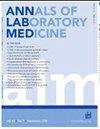维生素K缺乏:诊断和管理。
IF 3.9
2区 医学
Q1 MEDICAL LABORATORY TECHNOLOGY
引用次数: 0
摘要
维生素K (VK)缺乏(VKD)通常会导致凝血功能障碍。还原形式的VK是翻译后凝血因子(Fs) II, VII, IX和X的γ-羧化的重要辅助因子;蛋白质C和S;还有额外的蛋白质。这种羧基化产生了高亲和力的钙结合位点,这对它们的功能很重要。VK是一种脂溶性维生素,日常所需的一半由饮食中的维生素K1满足(尤其是绿叶蔬菜),另一半由肠道菌群产生的维生素K2满足。由于VK的组织储存有限,VKD可在几天内发展。VKD增加了出血的风险,新生儿和婴儿的风险最高,除非他们在出生时进行常规VK预防。由于VK异构体的不同形式和半衰期,诊断VKD具有挑战性。通常,怀疑有vkd相关凝血功能障碍的患者在接受VK后1-2天内评估凝血功能障碍的矫正,无论是口服还是肠外治疗。VKD增加了由VK缺失引起的血浆蛋白水平,如des-γ-羧化因子II,它更常被用作肝细胞癌的生物标志物,而不是作为VKD的生物标志物。VKD导致基于凝血酶原时间(PT)而不是Ecarin试剂的因子试验测量的FII水平显着差异,因为Ecarin凝血酶原激活剂直接将正常和des γ-羧化的FII转化为减凝血酶(导致FII水平高于PT试剂估计的水平)。在这篇综述中,我们总结了目前关于VKD的病因、后果、诊断、预防和治疗的信息。本文章由计算机程序翻译,如有差异,请以英文原文为准。
Vitamin K Deficiency: Diagnosis and Management.
Vitamin K (VK) deficiency (VKD) commonly causes coagulopathy across the age spectrum. The reduced form of VK is an essential cofactor for the post-translational γ-carboxylation of coagulation factors (Fs) II, VII, IX, and X; proteins C and S; and additional proteins. This carboxylation creates high-affinity calcium-binding sites that are important for their functions. VK is a fat-soluble vitamin, with half of the daily needs met by vitamin K1 from the diet (particularly green leafy vegetables) and the other half met by vitamin K2 produced by gut flora. VKD can develop within days because of limited tissue stores of VK. VKD increases risks for bleeding, with neonates and infants at the highest risk unless they are administered routine VK prophylaxis at birth. Diagnosing VKD is challenging because of the different forms and half-lives of VK isoforms. Often, patients with suspected VKD-related coagulopathies are assessed for coagulopathy correction within 1-2 days after receiving VK, either orally or parenterally. VKD increases the plasma levels of proteins induced by the absence of VK, such as des-γ-carboxylated factor II, which is more commonly used as a biomarker for hepatocellular carcinoma than as a VKD biomarker. VKD causes notable discrepancies in FII levels measured by factor assays based on the prothrombin time (PT) rather than Ecarin reagents, as the Ecarin prothrombin activator directly converts normal and des-γ-carboxylated FII to meizothrombin (resulting in higher FII levels than estimated with PT reagents). In this review, we summarize current information on the causes, consequences, diagnosis, prevention, and treatment of VKD.
求助全文
通过发布文献求助,成功后即可免费获取论文全文。
去求助
来源期刊

Annals of Laboratory Medicine
MEDICAL LABORATORY TECHNOLOGY-
CiteScore
8.30
自引率
12.20%
发文量
100
审稿时长
6-12 weeks
期刊介绍:
Annals of Laboratory Medicine is the official journal of Korean Society for Laboratory Medicine. The journal title has been recently changed from the Korean Journal of Laboratory Medicine (ISSN, 1598-6535) from the January issue of 2012. The JCR 2017 Impact factor of Ann Lab Med was 1.916.
 求助内容:
求助内容: 应助结果提醒方式:
应助结果提醒方式:


